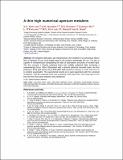Files in this item
Thin high numerical aperture metalens
Item metadata
| dc.contributor.author | Kotlyar, V. V. | |
| dc.contributor.author | Nalimov, A. G. | |
| dc.contributor.author | Stafeev, S. S. | |
| dc.contributor.author | Hu, Changyu | |
| dc.contributor.author | O'Faolain, L. | |
| dc.contributor.author | Kotlyar, M. V. | |
| dc.contributor.author | Gibson, D. | |
| dc.contributor.author | Song, S. | |
| dc.date.accessioned | 2018-04-03T23:34:21Z | |
| dc.date.available | 2018-04-03T23:34:21Z | |
| dc.date.issued | 2017-04-03 | |
| dc.identifier | 249577739 | |
| dc.identifier | 96da7f0d-b31f-4e3d-8b0e-b8ba58b8fcff | |
| dc.identifier | 85017028646 | |
| dc.identifier | 000398536000091 | |
| dc.identifier.citation | Kotlyar , V V , Nalimov , A G , Stafeev , S S , Hu , C , O'Faolain , L , Kotlyar , M V , Gibson , D & Song , S 2017 , ' Thin high numerical aperture metalens ' , Optics Express , vol. 25 , no. 7 , pp. 8158-8167 . https://doi.org/10.1364/OE.25.008158 | en |
| dc.identifier.issn | 1094-4087 | |
| dc.identifier.other | Bibtex: urn:8d5d59addcc7d15d61b2abb13208a3aa | |
| dc.identifier.uri | https://hdl.handle.net/10023/13062 | |
| dc.description | RF Ministry of Education and Science, RF President's grants for support of young candidates of science (MK-9019.2016.2) and leading scientific schools (NSh-9498.2016.9), and RFBR grants ## 15-07-01174, 15-37-20723, 15-47-02492, 16-29-11698, the European Research Council (ERC) under the European Union's Seventh Framework Programme (FP7/2007-2013) / ERC grant agreement n°337508, Federal Agency for Scientific Organizations. | en |
| dc.description.abstract | We designed, fabricated, and characterized a thin metalens in an amorphous silicon film of diameter 30 µm, focal length equal to the incident wavelength 633 nm. The lens is capable of simultaneously manipulating the state of polarization and phase of incident light. The lens converts a linearly polarized beam into radially polarized light, producing a subwavelength focus. When illuminated with a linearly polarized Gaussian beam, the lens produces a focal spot whose size at full-width half-maximum intensity is 0.49λ and 0.55λ (λ is incident wavelength). The experimental results are in good agreement with the numerical simulation, with the simulated focal spot measuring 0.46λ and 0.52λ. This focal spot is less than all other focal spots obtained using metalenses. | |
| dc.format.extent | 10 | |
| dc.format.extent | 800448 | |
| dc.language.iso | eng | |
| dc.relation.ispartof | Optics Express | en |
| dc.subject | Binary optics | en |
| dc.subject | Microstructure fabrication | en |
| dc.subject | Polarization-selective devices | en |
| dc.subject | Diffractive lenses | en |
| dc.subject | Near-field microscopy | en |
| dc.subject | Subwavelength structures | en |
| dc.subject | QC Physics | en |
| dc.subject | NDAS | en |
| dc.subject.lcc | QC | en |
| dc.title | Thin high numerical aperture metalens | en |
| dc.type | Journal article | en |
| dc.contributor.sponsor | European Research Council | en |
| dc.contributor.institution | University of St Andrews. School of Physics and Astronomy | en |
| dc.contributor.institution | University of St Andrews. Microphotonics and Photonic Crystals Group | en |
| dc.identifier.doi | https://doi.org/10.1364/OE.25.008158 | |
| dc.description.status | Peer reviewed | en |
| dc.date.embargoedUntil | 2018-04-03 | |
| dc.identifier.grantnumber | 337508 337508 | en |
This item appears in the following Collection(s)
Items in the St Andrews Research Repository are protected by copyright, with all rights reserved, unless otherwise indicated.

